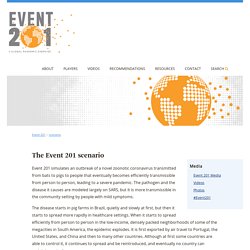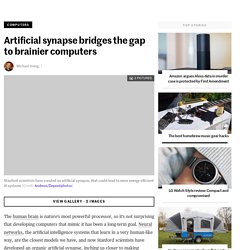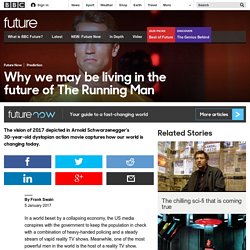Speculating on the Future
> Puhn
> How It All Works
A pandemic tabletop exercise. Event 201 simulates an outbreak of a novel zoonotic coronavirus transmitted from bats to pigs to people that eventually becomes efficiently transmissible from person to person, leading to a severe pandemic.

The pathogen and the disease it causes are modeled largely on SARS, but it is more transmissible in the community setting by people with mild symptoms. The disease starts in pig farms in Brazil, quietly and slowly at first, but then it starts to spread more rapidly in healthcare settings. When it starts to spread efficiently from person to person in the low-income, densely packed neighborhoods of some of the megacities in South America, the epidemic explodes. It is first exported by air travel to Portugal, the United States, and China and then to many other countries. Although at first some countries are able to control it, it continues to spread and be reintroduced, and eventually no country can maintain control. The scenario ends at the 18-month point, with 65 million deaths.
How a Machine That Can Make Anything Would Change Everything. From time to time, the Singularity Hub editorial team unearths a gem from the archives and wants to share it all over again.

It’s usually a piece that was popular back then and we think is still relevant now. This is one of those articles. It was originally published December 25, 2017.
Kim Stanley Robinson: The Good Anthropocene – Locus Online. Whose Dystopia Is It Anyway?
By Mike Riggs, Katherine Mangu-Ward, Todd Krainin, Nick Gillespie, Jesse Walker, Robby Soave, Eric Boehm, Christian Britschgi, Peter Suderman & Brian Doherty Source: Reason.

Computer Predictions from 1979 - The Awesomer. How the Cloud and Artificial Intelligence Will Change Your Life - Gear Patrol. At Microsoft’s Build conference in Seattle last week — its annual seminar/dog-and-pony-show for software developers, similar to Apple’s Worldwide Developers Conference — one thing became abundantly clear: the Apple vs.

Microsoft war is over. Microsoft won. Well, so did Apple.
Analysis predicts extremely disruptive, total transition to EV / autonomous vehicles in 13 years. (Tech Xplore)—RethinkX, an independent think tank that analyzes and forecasts disruptive technologies, has released an astonishing report predicting a far more rapid transition to EV/autonomous vehicles than experts are currently predicting.

The report is based on an analysis of the so-called technology-adoption S-curve that describes the rapid uptake of truly disruptive technologies like smartphones and the internet. Additionally, the report addresses in detail the massive economic implications of this prediction across various sectors, including energy, transportation and manufacturing. Rethinking Transportation 2020-2030 suggests that within 10 years of regulatory approval, by 2030, 95 percent of U.S. passenger miles traveled will be served by on-demand autonomous electric vehicles (AEVs).
Log In - New York Times. Artificial synapse bridges the gap to brainier computers. The human brain is nature's most powerful processor, so it's not surprising that developing computers that mimic it has been a long-term goal.

Neural networks, the artificial intelligence systems that learn in a very human-like way, are the closest models we have, and now Stanford scientists have developed an organic artificial synapse, inching us closer to making computers more efficient learners. In an organic brain, neuronal cells send electrical signals to each other to process and store information. Neurons are separated by small gaps called synapses, which allow the cells to pass the signals to each other, and every time that crossing is made, that connection gets stronger, requiring less energy each time after.
That strengthening of a connection is how the brain learns, and the fact that processing the information also stores it is what makes the brain such a lean, mean, learning machine. Neural networks model this on a software level.
What the World Might Look Like in 5 Years, According to US Intelligence. Every four years, a group of U.S. intelligence analysts tries to predict the future.

And this year, in a report released just weeks before Donald Trump assumes the presidency, those analysts forecast a massive shift in international affairs over the next five years or so: “For better and worse, the emerging global landscape is drawing to a close an era of American dominance following the Cold War,” the study argues. “So, too, perhaps is the rules-based international order that emerged after World War II.” Trump has repeatedly expressed opposition to key elements of this international order—specifically free-trade deals, U.S. alliance arrangements, and America’s promotion of democracy abroad.
Future - Why we may be living in the future of The Running Man. In a world beset by a collapsing economy, the US media conspires with the government to keep the population in check with a combination of heavy-handed policing and a steady stream of vapid reality TV shows.

Meanwhile, one of the most powerful men in the world is the host of a reality TV show. Sound familiar? That was 2017 conjured by campy action thriller The Running Man when it was released 30 years ago. Sci-fi commonly reveals hidden truths about society.
Will we discover a twin Earth? 20 big questions about the future of humanity. 1.

Does humanity have a future beyond Earth? “I think it’s a dangerous delusion to envisage mass emigration from Earth. There’s nowhere else in the solar system that’s as comfortable as even the top of Everest or the South Pole.
Super-Intelligent Humans Are Coming - Issue 18: Genius. Lev Landau, a Nobelist and one of the fathers of a great school of Soviet physics, had a logarithmic scale for ranking theorists, from 1 to 5.

A physicist in the first class had ten times the impact of someone in the second class, and so on.
The future will be built on open data – here's why. 2015 Technology Predictions: Some Good, Some Bad, None Impressive. For a couple of years now I’ve been following Mark Anderson’s yearly top 10 tech at Strategic News Service. It is claimed that he has a 94% success rate (though it’s unclear if this claim comes directly from Anderson himself). Last year, I calculated his success rate at closer to around 60% (and it had been worse in prior years), so I was eager to see how he did it this year.
Now, you must realize that his predictions are in no way paranormal. Not paranormal … He seems to have access to C-level executives in several high-profile tech companies, which he interviews about their plans for the future.
Philosophical Disquisitions: Demanding a Post-Work World: Technological Unemployment and the Human Future. The political left has long been oriented toward the future.
Mad Men of the future will be brain scientists and dream experts. It’s been 60 years since the first TV ad was broadcast in the UK.
In that time, we’ve moved from the innocent grainy black-and-white “Tingle of Health” of Gibbs SR toothpaste, to the sophisticated hyper-reality of 4K TV and beyond, in lock-step with developing communications technologies. The next 60 years will certainly see an even faster pace of change. So what can we look forward to (or not) in the realm of advertising?
Astrobiologist Thinks Mars Colonies Should Declare Their Independence from Earth. The world is fascinated by the idea of establishing bonafide colonies on Mars, and there is a chance it could happen one day (although we have a very, very long way to go).
The fate of the universe: heat death, Big Rip or cosmic consciousness?
Black holes will be all that remains before the universe enters heath death.
But the story doesn’t end there… NASA/ESA/wikimedia By piecing together an increasing number of clues, cosmologists are getting closer to understanding what the future and ultimate fate of the universe will be.
Huffingtonpost. We Can’t Find Any Alien Neighbors and Virtual Reality Might Be to Blame. “If the transcension hypothesis is correct, inner space, not outer space, is the final frontier for universal intelligence. Our destiny is density.” – John Smart. Eternal Life for the One Percent?
The future according to anime — Hopes&Fears — flow "Film"
The Future: 1972. It’s common for folks like myself and the readers of this blog to frequent sites and browse magazines filled with articles about leaps in information processing, advances in artificial intelligence, and the future of human/machine interfacing. It’s the 21st century after all, and even though many of our institutions and officials are woefully culture-bound to reality paradigms that were cast aside many decades ago, the rest of us are living in the future.
“We are in a revolutionary moment”: Chris Hedges explains why an uprising is coming — and soon. How to Build a Universe That Doesn't Fall Apart Two Days Later. It’s a sci-fi trope, but are “beings of pure energy” really possible?
Wikiwand. What I Learned About the Future by Reading 100 Science Fiction Books.
Over the past two years I’ve read 100 sci-fi novels, averaging about one per week.
Philip K. Dick was right: we are becoming androids. In Do Androids Dream of Electric Sheep?
, the Philip K. Dick novel that inspired the film Blade Runner, a bounty hunter pursues a group of androids who have been posing as human beings.
Businessinsider. Technology is perhaps the greatest agent of change in the modern world. While never without risk, technological breakthroughs promise innovative solutions to the most pressing global challenges of our time.
‘Pornography Is What the End of the World Looks Like’
Could virtual reality change religion — and terrorize children?
Rollerball Amerika 2015. Top 10 Patents for 2014. The Transhuman World. The Eye of the Luddite: Ruminations on Anti-Technological Themes in the Rocky Series. After Humanity Has Been Destroyed, Robots Keep Fighting Our Final War.
Post-Scarcity Societies (That Still Have Scarcity)
Boring Future, Volume 1. Hollywood Must Turn Its Head to Personalized Longevity Science instead of Anti-Aging Pseudoremedies. Louis C.K. Was Right About The Cloud All Along. Are we heading for technological unemployment? An Argument. Fermilab experiment will attempt to answer whether we actually live in "the Matrix"
Robots could murder us out of kindness, says futurist. Homni: The new superorganism taking over Earth. Cryopreservation: ‘I freeze people to cheat death’
Blogs - Adam Curtis - NOW THEN. Beauty Is Skin-deep—But That’s Where Genetic Engineering Is Going Next. Academics dream of electric sex workers. Www.aleph.se/Nada/dysonFAQ.html. The science of 'Transcendence' isn't just fiction—it's terrifyingly real. NASA: Industrial civilization headed for ‘irreversible collapse’
Science & Environment - Timeline of the far future. The Dumbass Haunted World – When Propaganda Masquerades as Science. An Artist Imagines the Techno-Evolved Creatures of the Future. Ftp/arxiv/papers/1312/1312.7128.pdf. Scientist searching Twitter for time travelers tells Raw Story why he’s looking for Pope Francis. Visit to the World's Fair of 2014. How far should we trust scientific models? – Jon Turney. A Plan To Have Humans Give Birth To Dolphins And Then Eat Them. Home / BMC Labs. David Cronenberg's POD Implant For Your Brain. 9 Things That Could Positively Influence the World if we Re-Directed Our Resources from War. Future Earth: Agenda 21′s ‘Forbidden Zones’
Future, Please: Cybernetic Society. Paleofuture - A history of the future that never was. Exploring the Implications of Sacred Geometry – A Meeting of Minds. Interspecies telepathy: human thoughts make rat move - tech - 03 April 2013. Iranian scientist claims to have invented 'time machine'
What’s The Far Future Of Intelligence In The Universe?
Emerge 2013: Are cyborg humans and animals true life forms?
Report: Chinese Third-Graders Falling Behind U.S. High School Students in Math, Science. Drones could be used for stalking, voyeurism, says Congressional Research Service report.
THE FUTURIST Magazine Releases Its Top 10 Forecasts for 2013 and Beyond.










